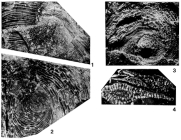Foraminifera taxon details
Spiroclypeus Douvillé, 1905 †
721538 (urn:lsid:marinespecies.org:taxname:721538)
accepted
Genus
Spiroclypeus orbitoideus Douvillé, 1905 † (type by original designation)
- Species Spiroclypeus albapustula Cole, 1957 †
- Species Spiroclypeus anghiarensis (Silvestri, 1907) †
- Species Spiroclypeus bintoetensis Zuffardi-Comerci, 1929 †
- Species Spiroclypeus blanckenhorni Henson, 1937 †
- Species Spiroclypeus bullbrooki Vaughan & Cole, 1941 †
- Species Spiroclypeus carpaticus (Uhlig, 1886) †
- Species Spiroclypeus globulus Nuttall, 1926 †
- Species Spiroclypeus higginsi Cole, 1939 †
- Species Spiroclypeus leupoldi van der Vlerk, 1925 †
- Species Spiroclypeus margaritatus (Schlumberger, 1902) †
- Species Spiroclypeus orbitoideus Douvillé, 1905 †
- Species Spiroclypeus pustulosus Douvillé, 1916 †
- Species Spiroclypeus ranjanae Tewari, 1956 †
- Species Spiroclypeus reticulatus Azzaroli, 1958 †
- Species Spiroclypeus sirottii Less & Özcan, 2008 †
- Species Spiroclypeus tewarii Singh, 1977 †
- Species Spiroclypeus tidoenganensis van der Vlerk, 1925 †
- Species Spiroclypeus tudertis Silvestri, 1907 †
- Species Spiroclypeus vermicularis Tan, 1937 †
- Species Spiroclypeus wolfgangi van der Vlerk, 1925 †
- Species Spiroclypeus granulosus Boussac, 1906 † accepted as Spiroclypeus carpaticus (Uhlig, 1886) † (Subjective junior synonym Opinion of Less and Özcan (2008))
- Species Spiroclypeus yabei van der Vlerk, 1925 † accepted as Tansinhokella yabei (van der Vlerk, 1925) † (Type species of Tansinhokella)
marine, brackish, fresh, terrestrial
fossil only
masculine
Douvillé, H. (1905). Les Foraminifères dans le Tertiaire de Bornéo. <em>Bulletin de la Société géologique de France.</em> (4)5(4): 435-464., available online at https://www.biodiversitylibrary.org/page/31027682
page(s): p. 458 [details]
page(s): p. 458 [details]
Hayward, B.W.; Le Coze, F.; Vachard, D.; Gross, O. (2024). World Foraminifera Database. Spiroclypeus Douvillé, 1905 †. Accessed at: https://marinespecies.org/foraminifera/aphia.php?p=taxdetails&id=721538 on 2024-04-23
Date
action
by
original description
Douvillé, H. (1905). Les Foraminifères dans le Tertiaire de Bornéo. <em>Bulletin de la Société géologique de France.</em> (4)5(4): 435-464., available online at https://www.biodiversitylibrary.org/page/31027682
page(s): p. 458 [details]
basis of record Loeblich, A. R.; Tappan, H. (1987). Foraminiferal Genera and their Classification. Van Nostrand Reinhold Company, New York. 970pp., available online at https://books.google.pt/books?id=n_BqCQAAQBAJ [details] Available for editors [request]
[request]
page(s): p. 458 [details]
basis of record Loeblich, A. R.; Tappan, H. (1987). Foraminiferal Genera and their Classification. Van Nostrand Reinhold Company, New York. 970pp., available online at https://books.google.pt/books?id=n_BqCQAAQBAJ [details] Available for editors
 Present
Present  Inaccurate
Inaccurate  Introduced: alien
Introduced: alien  Containing type locality
Containing type locality
From editor or global species database
Diagnosis Test lenticular to discoidal, planispirally coiled and involute, with rapidly enlarging whorls of numerous strongly curved chambers that increase rapidly in height but very slowly in width, earliest one or two coiled chambers may be undivided but later ones have numerous complete secondary septa as in Heterostegina, lateral chamberlets formed by backward folding of the entire proximal primary lateral wall and alar prolongations, details of canal system not known, Y-shaped supplementary stolons occur in the median plane and where the fold of the septal flap touches the inner apertural wall, lateral pillars perpendicular to the surface; wall calcareous, finely perforate, spiral wall thick, surface may be pustulose in the umbonal region. U. Eocene to L. Miocene; Europe; Africa; West Indies; Borneo; Saipan. (Loeblich & Tappan, 1987, Foraminiferal Genera and Their Classification) [details]
